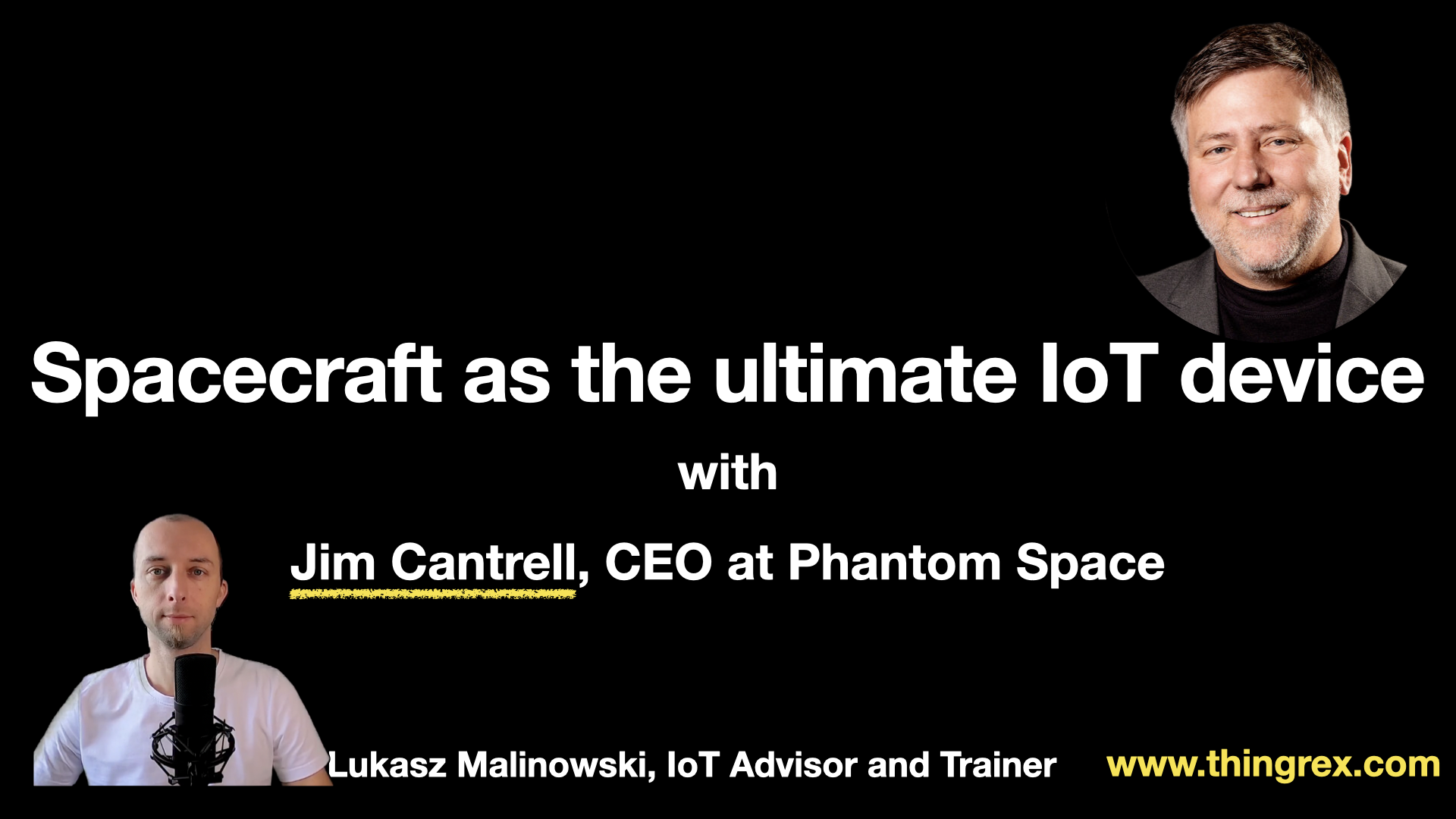
Contents
Introduction
Space is the ultimate destination for the Internet of Things technology. Satellites are a perfect example of IoT devices operating in hard-to-reach places.
Jim Cantrell, the CEO at Phantom Space, shares his 30+ years of experience with me during this discussion.
We covered several important topics, including:
- How has the space industry evolved over the years?
- What is the concept of software-defined satellites?
- How can we protect satellites from cyber-attacks?
- What factors impact satellites’ lifespan?
- What are the cost factors of getting things into space, and how do you reduce them?
That is just a small subset of the subjects we discussed.
Video
Below, you can find my notes from this meeting.
Meeting Notes
Jim’s Track Record
- Worked at the French space agency and in the former Soviet Union.
- Helped start SpaceX in 2001.
- Involved in 11 startups over 30 years.
- Currently, he is the CEO of Phantom Space, building launch vehicles and satellites.
Space as Ultimate Destination for IoT Devices
- IoT involves taking data from machines and transmitting it to users.
- Terrestrial networks currently support IoT.
- Space networks can enable global monitoring and control of remote machinery.
Managing Satellite Density
- Space is vast, with crowded and uncrowded areas.
- Satellites need to be placed in different orbits to avoid collisions and allow natural atmospheric cleansing.
- Innovation in space transportation systems is crucial for satellite replacement and technology upgrades.
- Government regulation for third-party collision insurance can incentivize responsible satellite placement.
- US Air Force’s system tracks objects in orbit and shares data for monitoring.
Satellite Lifespan and Upgrades
- Satellites are designed to operate for roughly ten years in orbit, mainly limited by power and solar panel degradation due to radiation.
- Solar panels degrade over time, reducing the satellite’s power supply.
- Satellites also die if they run out of fuel for maneuvering.
- Hardware components are not easily upgraded.
- Software upgrades, similar to consumer electronics, are being implemented to extend satellite lifespan.
Electronics Design for Satellites
- In the past, radiation-hardened electronics were used to protect against radiation damage in space.
- High-energy particles can cause damage to electronics.
- Today, commercial electronics are used in satellites, often with redundancy or voting architectures, to mitigate potential damage.
- Solar cells still face degradation over time, posing a challenge to satellite longevity.
Software-Defined Satellites
- Satellites are moving towards a software-defined model, similar to computers and smartphones.
- Different functionalities can be run simultaneously within the satellite, allowing for more flexibility and adaptability.
- The concept allows for multiple satellite personalities to operate simultaneously, with the ability to route data to different parts of the satellite as needed.
Defending Satellites Against Cyber Attacks
- Cyber attacks targeting satellites are a growing concern.
- There is a need to defend both existing satellites in orbit and future satellite designs against such attacks.
- The vulnerability of satellites to cyber attacks, especially those already in orbit, is a significant but often overlooked issue.
- Incidents like the one involving Starlink highlight the potential risks posed by cyber-attacks on satellites.
Concerns about Satellite Security
- Encryption was used in old systems to prevent unauthorized access to satellites.
- Ground stations would communicate directly with the satellite using encrypted traffic.
- With the shift to networked systems, similar issues to Internet-connected devices arise.
- US Air Force makes efforts to identify vulnerabilities of satellites operating in orbit.
Impact of Quantum Computing
- Quantum computers will break encryption.
- There is a risk of compromising data security in space and financial systems.
- Finding solutions to this security threat is not apparent.
Space Situation Awareness Sensors
- Various sensors are used for space situation awareness.
- Examples include startrackers and telescopes.
- It is vital to understand “what” is in space and what it is “doing” for commercial and national security purposes.
Making Space More Accessible
- Jim’s vision is to make space more accessible and cost-effective.
- He leverages Henry Ford’s mass manufacturing approach.
- My guest underlined the importance of infrastructure, such as launch vehicles and data backhaul, in the commercial space industry.
Cost Reduction Strategies
- Building a lot of identical launch vehicles and satellites to reduce costs.
- Small size allows for launching equivalent mass to space with more vehicles.
- Reusability, as proven by SpaceX, reduces replacement costs.
- A greater number of launches enables amortization of staff costs.
- Working on launch sites to increase availability and throughput.
Launch Range Sites and Regulatory Authorities
- Launch sites are limited and strategically located.
- Launching over water is preferred to minimize risk to people.
- Jim highlighted the future potential for launching from inland areas.
Satellite Services and Operational Management
- Phantom Space aims to provide the Satellite-as-a-Service and manage operational complexity.
- Managing complexity becomes easier with experience and established procedures.
Advice for entering the Space Business
- Passion is the key; you must love the work you are doing.
- Collaboration and raising money are essential due to the scale and capital requirements.
- Consider starting with less ambitious projects and gaining experience.
- Be open to opportunities, even if they seem unconventional or ambitious.
- Respect experience over technology supremacy.
Let me know what the most valuable takeaway for you!

